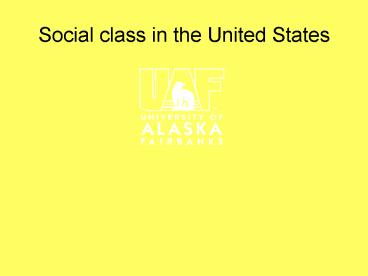Social class in the United States - PowerPoint PPT Presentation
1 / 19
Title:
Social class in the United States
Description:
Public view: there is no class in American society ... Christian white males of English, Scots, and German origin (WASP='White Anglo-Saxon Protestant' ... – PowerPoint PPT presentation
Number of Views:98
Avg rating:3.0/5.0
Title: Social class in the United States
1
Social class in the United States
2
Social class and social status
- Topic of much controversy
- Many competing definitions
- Public view there is no class in American
society - Alternate view social status is determined by
achievement - Confused by comparison with very different
British class system
3
English class structure
- Differ by accents, clothing, politics
- Hereditary upper class (aristocrats)
- Old aristocrats (from ancesters' merits)
- New aristocrats (from personal merit)
- Middle class
- upper - professionals
- lower shopkeepers, small businesses, teachers
- Working class (labour)
- Little social mobility
4
Historical background to social class in the
United States
- English settlement
- Revolution
- Massive 19th century immigration
- 2nd World War and meritocracy
- 1970's revolution in role of women
5
Influence of English settlement on social class
in the United States
- 1607-1776 (British Colony)
- Hereditary (English) upper class
- Colonial lower-upper class of large landowners
and wealthy businessmen - Examples
- George Washington,
- John Adams,
- Thomas Jefferson
- Middle class of professionals, business owners
and farm owners - Lower class of workers and landless farmers
- Lowest class of slaves
6
Influence of the 1776 Revolution on social class
in the United States
- Ideology of equality myth that all (but slaves)
were middle class - Abolition of hereditary upper class
- Replacement by large landowners and wealthy
businessmen - More opportunities for the middle class
- Government programs to provide land for landless
farmers
7
Influence of massive 19th century immigration on
social class in the United States
- Successful native" born Americans at the top
- Beginning of "aristocracy of birth"
- Desirable" immigrants (English, Scots, Germans)
- "White trash" (unsuccessful native" born
Americans - Less desirable" immigrants (Irish, Italians,
Eastern Europeans, Jews) - Undesirable" immigrants (Asians)
- ex-slaves
8
Situation before WW2 (experienced by most
post-war educated Chinese leaders)
- US run by a few wealthy families
- 19th century trade
- Early capitalism
- Professions (upper middle class) primarily
protestant Christian white males of English,
Scots, and German origin (WASPWhite Anglo-Saxon
Protestant) - Admission to best colleges and professions mostly
by social connections - 4.6 of the adult population had a college degree
(in 2007 it is 25)
9
Influence of the 2nd World War and meritocracy on
social class in the United States
- Meritocracy rule by most qualified
- Problem of incompetent "social" officers in army
- Response
- Programs of training and testing
- Promotion based on performance
- Programs at end of war
- College education paid for all veterans
- College admission for merit rather than family
- Nation-wide standard entrance examinations
10
Influence of the 2nd World War and meritocracy on
social class in the United States, continued
- Admission to professions by education and
licensing (both determined by examination rather
than connections) - Public intolerance of non-merit-based promotion
- Civil rights programs to open education and
professions to minorities - Womens movement opened education and professions
to women
11
Influence of the 1970's revolution in role of
women on social class in the United States
- Opening of all professions to women
- Major shift in marriage patterns
- Temporary increase in divorce rate
- Increase in income-inequality based on marriage
12
Pre-1965 marriage patterns
- Upper and middle class women did not work
- Wives roles
- raising children
- managing house
- entertaining
- charity
- Successful men often married younger, attractive
women from lower background - e.g. professionals married secretaries
- Impact lessening class differences
13
Post-1975 marriage patterns
- Upper and middle class women usually work
- Wives roles
- earning money
- raising (fewer) children
- professional success
- Successful men usually marry women at their own
educational and professional level - Impact
- increasing class and income differences
- Decline in marriage rates at lower social levels
14
Factors in American class structure
- wealth,
- income,
- education,
- type of occupation,
- membership in social networks
15
Simple three-class model
- Most commonly accepted
- the "rich"
- the "middle class"
- the "poor"
16
6-level sociological model
- the rich and powerful
- upper middle class (highly educated and well-paid
professionals) - lower middle class (semi-professionals)
- working class (clerical and blue collar
employees) - working poor
- marginalized underclass
17
Alternative 6-level sociological model
- Old rich and powerful
- New rich and powerful
- upper middle class (highly educated and well-paid
professionals) - lower middle class (semi-professionals, clerical
and blue collar employees) - working poor
- marginalized underclass
18
Continuum model
- Accepted by most people
- Almost everyone is "middle" class
- There are minor social status differences between
people - social status is determined by achievement
- social status changes (usually upward) over life
19
Important things to consider
- Americans are uncomfortable talking about social
class it is not supposed to exist - To a large extent in the long term one can choose
one's social class, since major determinants for
young people are - education,
- type of occupation,
- membership in social networks
- Social networks include religious networks many
Chinese in the US choose these badly - You cannot control what you do not understand































